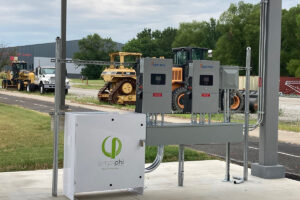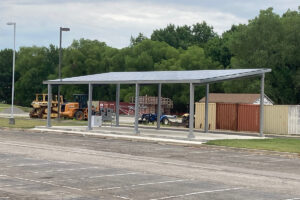Delivering water more sustainably to Johnson County
Situated near 91st and Lamar in Overland Park, Kansas, WaterOne’s Lamar Pump Station plays a vital role in delivering water to northeast Johnson County neighborhoods. Electricity use at the pump station peaks during the hottest summer months, when customer water usage increases. This is also the time of year that solar arrays provide peak output, making solar an ideal renewable resource for the plant.
“Not only does this array provide sustainable energy to the plant when it is most needed, it also helps alleviate stress on the larger electric grid when it is needed most – during those hot summer months when air conditioners are running at peak capacity,” said Travis Young, Lead Solar Developer for Evergy Energy Solutions (EES).
While the 100 kW array, built by EES, helps WaterOne power through the critical summer months, it produces energy year-round, helping WaterOne meet its broader corporate sustainability goals as well.
Type: Educational Institution
Completed: Aug 2022
4 Acre Ground Array
1,872 Solar Panels
750 kW Energy Generation
Bright Minds, Brighter Future: High School Leads the Way in Solar Innovation.
Spring Hill High School operates on all-electric, requiring a large amount of power. As a result, the facility’s peak demand (kW) reaches as high as 1.3 MW within the year. A 750 kW solar system was designed to produce a majority of the high school’s day time electric usage, and is integrated into a Building Automation System.
Together, these systems offer a “smart micro-grid” approach, reducing the peak demand as much as 30%. Annually the installation will offset about one third of the facility’s usage, reduce stress on the local grid, and save the school 30% on their electricity cost.
Spring Hill School District is championing sustainability by combining solar technology, native plant landscaping, and pollinator-friendly practices. This initiative transforms the land into a carbon-free renewable energy site, reducing reliance on fossil fuels and mitigating carbon emissions. Solar energy's water-free production preserves vital water resources, while pollinator-friendly grasses contribute to biodiversity, capturing carbon and improving water infiltration. This integrated strategy underscores the district's commitment to both energy efficiency and environmental conservation.
Canopy powers outdoor classroom while educating about solar energy.
Evergy Energy Solutions worked with Pittsburg State University to create a unique solar canopy that functions as an outdoor classroom, both teaching students about solar energy and how battery storage systems work.
Located near the Kansas Technology Center, the site is home to the university’s construction and automotive programs, which needed a solution to power an outside lab on the far north side of the parking lot. The canopy supplies energy to a 21 kilowatt-hour battery storage system, providing a means of consistent power delivery—enough capacity to run the power tools for a full day of classes.
"Battery storage systems can create new avenues when the typical solution doesn't work, or when electrical distribution is difficult." says Travis Young, Lead Solar Developer at Evergy Energy Solutions.
Additionally, the canopy doubles as a shelter for passersby on the nearby campus walkway. Featuring an informational plaque, it educates students about how solar arrays and battery storage systems work. In the future, the shaded area will contain picnic tables and phone charging for those want to stop and do a little studying.
Type: Recreational Facility
Built: 2021
78.4 kW Solar Canopy Entrance Awning
20 kW Solar Parking Canopy
Annual Production: 131,400 kWh
93 M Tons of CO2 Offset Per Year
114 Acres of Forest Per Year (carbon sequestered)
Enough to Power 12 Homes Per Year
Walking the talk: the role of the modern zoo to combat climate change.
For its 50th birthday, the Sedgwick County Zoo unveiled a new entry building and zoo store, both of which will run on 100% renewable energy. Featuring 250 panels on the canopy to their new entry building and an additional parking canopy, Evergy Energy Solutions collaborated with architects to integrate the solar arrays into the aesthetic of the additions. The panels are bi-facial, meaning they’ll pick up ultraviolet solar rays from above, and will also be able to pick up rays as they bounce back up from the concrete below. The Zoo's new environmental initiatives also include wind energy offsets from Evergy's Renewables Direct program, windows that prevent bird deaths, water conservation efforts, and the replacement of single-use plastics with compostables and refillable bottles.
“I think the role of the modern zoo and aquarium is more important today than it’s ever been,” said Dr. Jeff Ettling, the zoo’s executive director. “We all need to take action now because we’re seeing the dramatic impact that climate change is having here at home. We really need to walk the talk. It’s one thing to talk about conservation, it’s another to actually put it into action.”
Type: Government
Built: 2021
97 kW Rooftop and Carport Array on City Hall
119 kW Rooftop Array on Community Center
Annual Production: 270,000 kWh
190 Tons of CO2 Offset Per Year
234 Acres of Forest Per Year (carbon sequestered)
The Collective Desire for a Sustainable and Economically Prosperous Future.
As founding members of Climate Action KC, Roeland Park Mayor Mike Kelly and Council-member Lindsey Constance are working with other community leaders on a shared vision for a sustainable future. The plan: to help the Kansas City region achieve net zero emissions by 2050.
One of the steps that Roeland Park has taken to make the city cleaner and more energy efficient is the installation of solar panels on the roofs of the Community Center and City Hall, as well as a new solar-topped carport. Evergy Energy Solutions developed an agreement with Roeland Park, which the City estimates will provide a 236% internal rate of return and reduce carbon emissions by 10,000 tons over the life of the panels.
Type: Recreational Facility
Built: 2012
Annual Production: 90,500 kWh
66 M Tons of CO2 Offset Per Year
78 Acres of Forest Per Year (carbon sequestered)
Enough to Power 8 Homes Per Year
How the Chiefs went the Extra Yard for the Environment.
In 2014, the Chiefs announced a sustainability partnership with Evergy, installing 308 solar panels The University of Kansas Hospital Training Complex and Arrowhead Stadium. The partnership falls in line with the Chiefs "Extra Yard for the Environment" program, which is designed to devise and implement green policies for Arrowhead Stadium, the Chiefs, and fans at home. Other efforts include implementing more recycling bins throughout the stadium, community recycling drives, and the introduction of compostable peanut bags in 2017.
"Becoming a more environmentally-conscious organization has been and continues to be a long-term goal for us," Chiefs President Mark Donovan commented. "We operate a large stadium that uses a lot of energy, we wanted to find a way to do that better, make a positive impact in the community and be more efficient."
Rising to the challenge to reduce non-renewable resources.
The Kansas City Zoo believes that wildlife conservation begins at home. In partnership with Evergy, the Zoo installed solar arrays on nine roofs throughout their property. Notable is the Helzberg Penguin Plaza, which has panels covering half of its 19,000 square foot roof. A ground-level panel was installed so that visitors could see what they look like and how they work. Panels are also atop the Tuxedo Grill restaurant, Discovery Barn, Tropics exhibit, Wings of Wonder Auditorium, and Elephant Overlook.
Zoo Director Randy Wisthoff is dedicated to the use of solar power. “As a conservation organization, the Kansas City Zoo is always seeking to use renewable energy. One of the great things about solar power is that it produces its greatest output as demand spikes. Eleven buildings at the Zoo will utilize this resource, capturing and conserving energy at peak needed times, saving the Zoo money and saving the Earth’s resources.”
Type: Non-Profit
Built: 2014
17 kW Roof Mount Array
Annual Production: 22,500 kWh
16 Tons of CO2 Offset Per Year
20 Acres of Forest Per Year (carbon sequestered)
Saving Money through Solar energy in rural Missouri.
Nestled between farmland and a ball field on the outskirts of Blackburn, Missouri, is an unassuming building. From the road, it could be any other rural building topped with an American flag, but drive around the other side and you will find half the roof covered in a feature unique to the landscape: solar panels. Installed in 2014, the almost 60 panels help the Blackburn American Legion reduce their operating expenditures as well as their usage of non-renewable energy sources.









